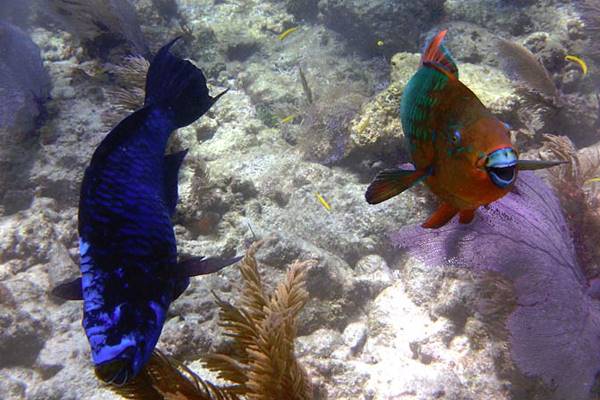Understanding the Roles of Native Species in Coral Reef Resilience
 Midnight and rainbow parrotfishes swim alongside a Caribbean coral reef. (Credit: Florida International University)
Midnight and rainbow parrotfishes swim alongside a Caribbean coral reef. (Credit: Florida International University)Coral reefs across the world have suffered in recent years as the complex ecosystems are particularly vulnerable to pollution and climate change. The Coral Reef Alliance reports that 75% of the world’s coral reefs are currently threatened, with the percentage expected to continue to climb if conditions don’t improve. As a result of the decline in reef health, many organisms that rely on the reefs for habitat are also becoming threatened as the environment deteriorates.
Why are Coral Reefs Threatened?
Coral has very strict temperature requirements to remain healthy. In waters that are too warm, coral releases the symbiotic algae that live inside them, leading the coral to turn white—a phenomenon known as coral bleaching. Coral that has been bleached can survive, but they are more vulnerable to disease and less resilient to high temperatures.
Sea level rises are also expected to harm coral reefs as the organisms rely on sunlight as a food source. The Coral Reef Alliance also stresses that sea level rise will lead to erosion of the shoreline, potentially introducing polluted runoff and sedimentation. More frequent and severe storm events create similar concerns, as heavy rainfall can lead to increases in polluted runoff.
Emissions from fossil fuels are absorbed by a variety of landscapes and organisms like oceans and trees. As the ocean continues to absorb carbon dioxide emissions, it will be more acidic in a process known as acidification. The Coral Reef Alliance states that acidification “affects the ability of reef-building corals to grow their skeletons and form the foundation for coral reefs.”
Ultimately, climate change and human-caused damages are making coral reefs, which house thousands of organisms and are a vital hub of biodiversity and resources, more susceptible to disease and population losses.
How do Native Species Protect Coral Reefs?
Much like other ecosystems, coral reefs are comprised of complex flora and fauna that contribute to the creation and structure of the reef. Small invertebrates like sea urchins live on the reef structure and help maintain vegetation and smaller organism populations. Similarly, according to the Smithsonian, herbivorous fish and coralivorous fish eat the coral and algae. Larger predator fish also help the reef by maintaining herbivore populations.
Unfortunately, climate change and related environmental stressors are also threatening non-coral species. Prior to the 1980s, sea urchins were abundant in the Caribbean, but the population has since declined, threatening the delicate system as sea urchins represent an important group of coral grazers. The loss threatened reefs throughout the Caribbean as poorly maintained reefs that are overgrown due to a lack of predators can become less resilient against disease and temperature.
Fortunately, reefs in the Caribbean have also seen an increase in the number of parrotfish—becoming the dominant species around reefs there. Research from Florida International University (FIU) found that parrotfish might be a good replacement for sea urchins.
The charismatic fish are quite popular with anglers due to their vibrant colors and unique appearance, and they are also a great substitute for sea urchins because parrotfish regularly graze on algae growth, keeping the coral clean. The fish also scrape the substrate as they feed, which helps to clear space on coral reefs that are taken up by algae growth and help fend off coral shading. For comparison, most other grazers consume algae like lawnmowers, grazing only from the top, which doesn’t open up new space on corals.
Conclusion
While parrotfish are helping to maintain reefs in the Caribbean, increasing native grazing populations may not be a global solution. The FIU study revealed that grazing behavior was difficult to predict and that unpredictability makes it challenging to utilize parrotfish as a means of protecting reefs.
The results of the study and other standing knowledge on how native populations maintain reefs are essential to understanding how to protect reefs—particularly when so many of the world’s reefs are threatened by ocean acidification, global warming and large mortality events of corals.


0 comments